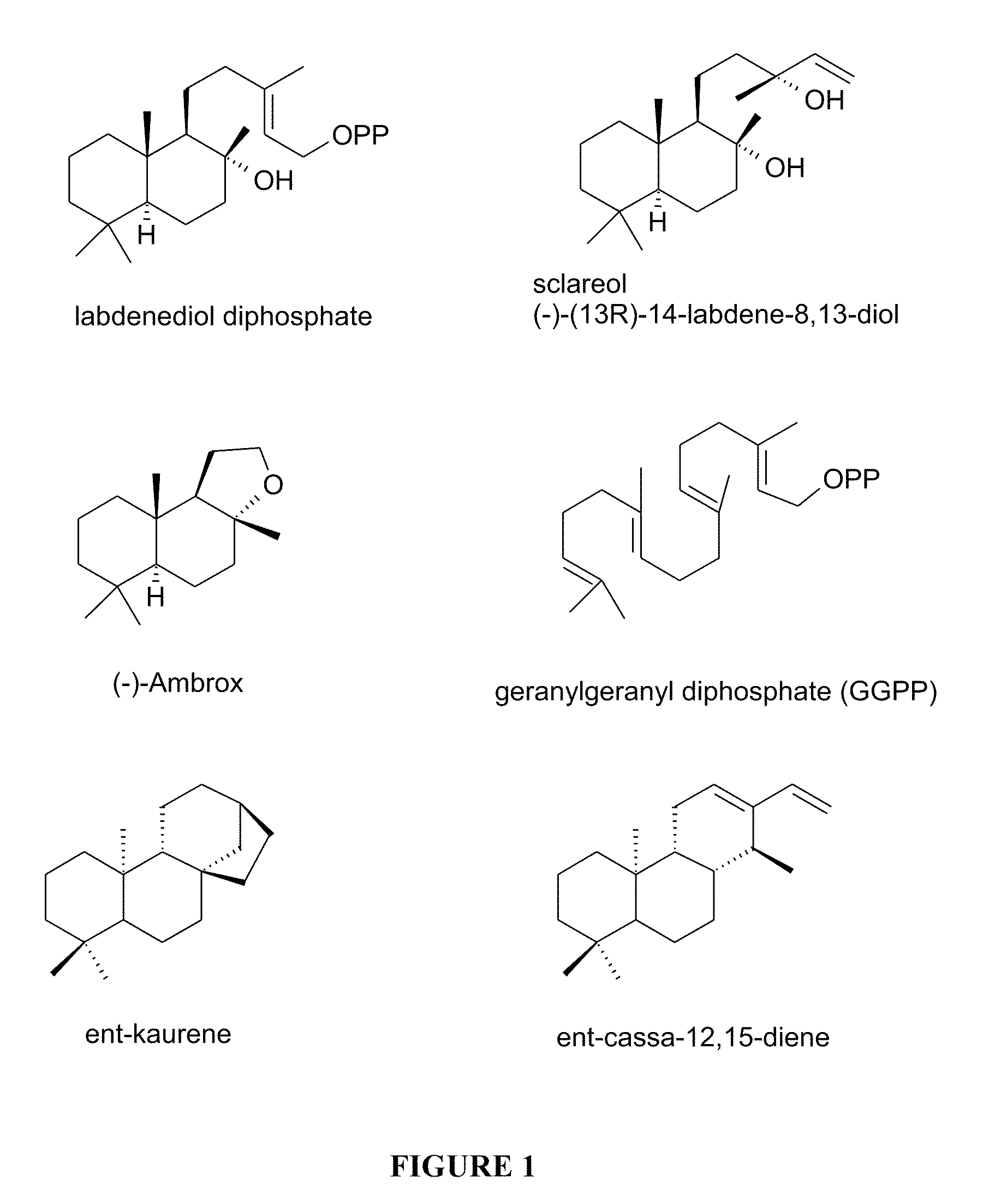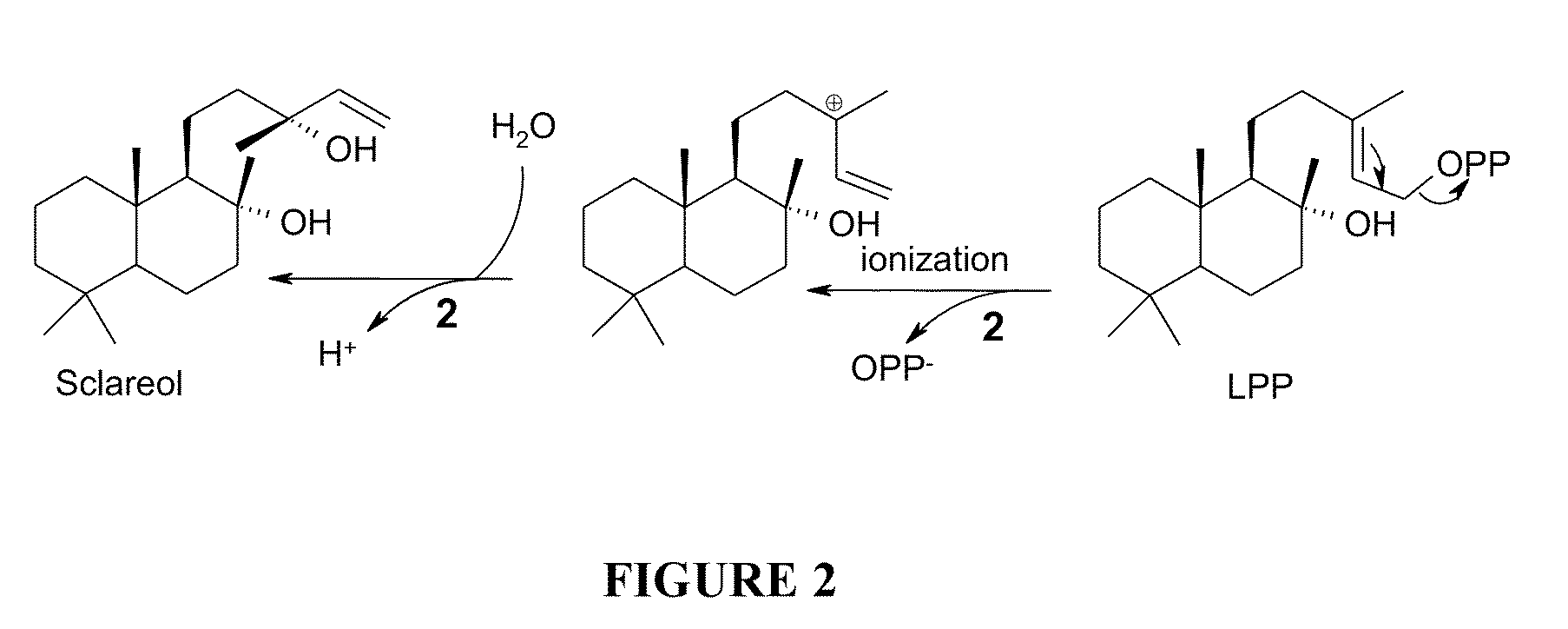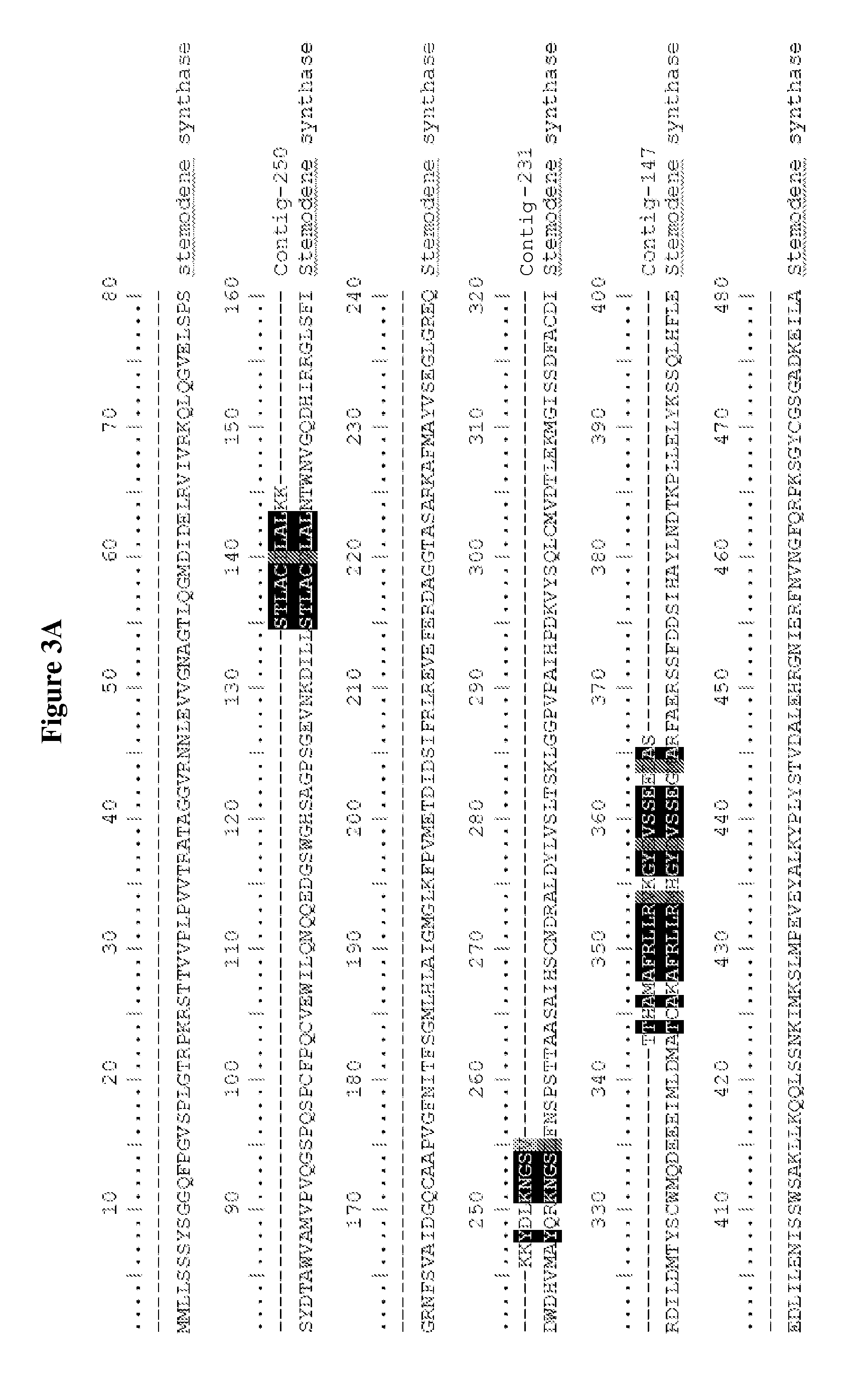Method for producing sclareol
a sclareol and biosynthetic technology, applied in the field of sclareol production, can solve the problems of not having a biosynthetic production method of sclareol, unable to meet the requirements of high-quality perfumery, and difficult to use such ingredients in high-quality perfumery
- Summary
- Abstract
- Description
- Claims
- Application Information
AI Technical Summary
Benefits of technology
Problems solved by technology
Method used
Image
Examples
example 1
Isolation of LPP Synthase Encoding cDNAs from Salvia clarea by a PCR Approach.
[0104]A. Plant Material and RNA Extraction.
[0105]Salvia sclarea developing flower buds (1.5 to 2 cm length, 1-2 days old) were collected in fields of Bassins (Switzerland) and directly frozen in liquid nitrogen.
[0106]Total RNA was extracted using the Concert™ Plant RNA Reagent from Invitrogen (Carlsbad, Calif.) and the mRNA was purified by oligodT-cellulose affinity chromatography using the FastTrack® 2.0 mRNA isolation Kit (Invitrogen, Carlsbad, Calif.) according to the manufacturer's instructions. A cDNA library was constructed using the Marathon™ cDNA Amplification Kit (Clontech, Mountain View, Calif.).
[0107]B. Polymerase Chain Reactions for Amplification of Diterpene Synthases cDNAs
[0108]PCR were performed using the forward primer DT3F (5′-GAYRTNGAYGAYACNGCNATGG-3′ (SEQ ID NO:3)) and the reverse primer DT4R (5′-GTYTTNCCNAKCCANACRTCRYYT-3′ (SEQ ID NO:4)). The PCR mixture contained 0.4 μM of each primer,...
example 2
[0112]Heterologous Expression of the S. sclarea LPP Synthase in E. coli.
[0113]The pETDuet-1 (Novagen, Madison, Wis.), designed for expression under the control of a T7 promoter, was used for expression in E. coli cells. To construct the expression plasmid, the open reading frame of SaTps1 (SEQ ID NO:16) was amplified by PCR from the cDNA library with the forward and reverse primers SaTps-Nde (3′-TACTGACATATGACTTCTGTAAATTTGAGCAGAGCACC-5′ (SEQ ID NO:18)) and SaTps-Kpn (3′-TTGGTACCTCATACAACCGGTCGAAAGAGTACTTTG-5′ (SEQ ID NO:19)) designed to introduce an NdeI site immediately before the start codon and a KpnI site after the stop codon. Since the open reading frame contains an NdeI site at position of 1614 of the open reading frame, this amplification was performed in two steps by overlap extension PCR (Horton et al, Gene 77, 61-68, 1989), using the primers SaTps-Nde (SEQ ID NO:18) and SaTps-Kpn (SEQ ID NO:19) in combination with the primers Satps-mut1f (5′-GTTGGAGTGGATCCACATGCAGGAATGGTA...
example 3
[0119]Purification of the LPP Synthase from Salvia sclarea and Enzymatic Activities
[0120]The PCR2.1-Topo plasmids containing the SsLPPs3 and SsLPPs9 cDNA (SEQ ID NO:22 and 23) (Example 2) were digested with NdeI and SacI and the inserts were ligated into the pET28a(+) plasmid (Novagen). The resulting expression plasmids (pET28-SsLPPs3 and pET28-SsLPPs9) contain the cDNAs with a 5′-end modification designed to express the proteins with an N-terminal hexa-histidine tag (His-tag). Purification was performed under native conditions using the ProBond™ Purification System (Invitrogen) following the manufacturer protocol excepted that, for the elution, imidazole was replaced by L-histidine to minimize inhibition of the enzyme. Using this approach, the SsLPPs3 and SsLPPs9 “His-tag” recombinant enzymes (SEQ ID NO:97 and 98) could be purified to apparent homogeneity.
[0121]The affinity purified enzymes were incubated 12 hours at 30° C. with 200 μM GGPP and 1 mM DTT in MOPSO pH 7, 10% glycerol,...
PUM
| Property | Measurement | Unit |
|---|---|---|
| optimal temperature | aaaaa | aaaaa |
| optimal temperature | aaaaa | aaaaa |
| optimal temperature | aaaaa | aaaaa |
Abstract
Description
Claims
Application Information
 Login to View More
Login to View More - R&D
- Intellectual Property
- Life Sciences
- Materials
- Tech Scout
- Unparalleled Data Quality
- Higher Quality Content
- 60% Fewer Hallucinations
Browse by: Latest US Patents, China's latest patents, Technical Efficacy Thesaurus, Application Domain, Technology Topic, Popular Technical Reports.
© 2025 PatSnap. All rights reserved.Legal|Privacy policy|Modern Slavery Act Transparency Statement|Sitemap|About US| Contact US: help@patsnap.com



